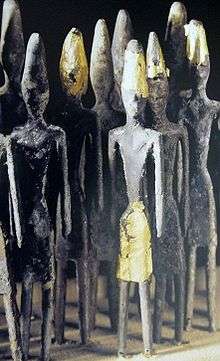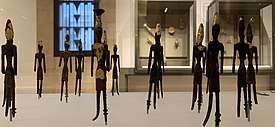Byblos figurines
The Byblos figurines or Phoenician statuettes are approximately 1,500–2,000 ex-voto statuettes found in ancient Phoenician temples in Lebanon, primarily in Byblos, but also in Kamid al lawz. The statuettes date to the second millenium BC and are made of bronze, silver, or copper alloy.[1][2][3] The Byblos figurines are considered to represent the best example of their kind across the Levant.[4][2]

Most of the figurines were found in the Temple of the Obelisks, in which 20 votive deposits and pitchers containing a variety of such figurines were found, along with a smaller, but important group of them found in the neighboring Temple of Baalat Gebal.[5][1][3] The figurines have been adopted to represent the Lebanese Tourism Ministry.[6]
Use
The majority of the statuettes were found at archaeological sites in sealed pottery jars, together with tools, weapons, jewelry, and other ritual objects.[7]
The first group found was located at the Temple of Baalat Gebal and information about them was published by archaeologists Montet and Dunand. Both originally considered the figurines to be "foundation deposits".[7] Following further discoveries at the Temple of the Obelisks, Dunand suggested that perhaps, they might be assemblages of "offering deposits" for festivals.[8] In 1966, however, Negbi and Moskowitz suggested instead, that the various objects discovered were hidden away in haste, ahead of an impending catastrophe.[9]
Description
The statuettes measure 3–38 cm tall, mostly represent males, and have tangs projecting from their feet that would have allowed them to be placed onto bases.[1] Most wear cone-shaped hats resembling the Egyptian hedjet and others wear helmets.[1] Some are nude and others wear short kilts.[1] Originally, many were armed with a stick, dagger, mace, or axe.[1] Based on an inscription on a large obelisk at the Temple of the Obelisks, the male ones are interpreted to resemble Resheph, the Phoenician deity of war and plague.[1]
The figurines have been described as "crude, stereotyped, mass-produced".[4] It is likely that they were produced in Byblos to be used as ritual offerings. Moulds for similar, but less numerous styles of statuettes, were found at the Phoenician excavations at Nahariya.[4]
They are interpreted as votive offerings because they were not found in graves and were not dispersed widely enough to be part of exchange networks.[4]
Gallery
National Museum of Beirut
The figurines on display at the National Museum of Beirut are pictured below:
 Figurine from the National Museum of Beirut
Figurine from the National Museum of Beirut Figurine from the National Museum of Beirut
Figurine from the National Museum of Beirut Figurine from the National Museum of Beirut
Figurine from the National Museum of Beirut Figurine from the National Museum of Beirut
Figurine from the National Museum of Beirut Figurine from the National Museum of Beirut
Figurine from the National Museum of Beirut Figurine from the National Museum of Beirut
Figurine from the National Museum of Beirut Figurine from the National Museum of Beirut
Figurine from the National Museum of Beirut Figurine from the National Museum of Beirut - including an atypical, female figurine
Figurine from the National Museum of Beirut - including an atypical, female figurine Figurine from the National Museum of Beirut
Figurine from the National Museum of Beirut Figurine from the National Museum of Beirut
Figurine from the National Museum of Beirut Figurine from the National Museum of Beirut
Figurine from the National Museum of Beirut
References
- Hakimian, Suzy (2008). "Byblos: Standing Figures". Beyond Babylon: Art, Trade, and Diplomacy in the Second Millennium B.C. Metropolitan Museum of Art. pp. 52–53. ISBN 978-1-58839-295-4.
More than fifteen hundred male figurines...
CS1 maint: ref=harv (link) - Seeden 1980, p. 36.
- Aubet, Maria Eugenia (31 January 2013). Commerce and Colonization in the Ancient Near East. Cambridge University Press. pp. 240–. ISBN 978-0-521-51417-0.
The most characteristic assemblage of offerings is without doubt the bronze figurines representing Baal, many of them covered in gold plate. Almost 2,000 figurines of this type have been found — an important group coming from the Temple of Baalat Gebal — the majority in the Temple of the Obelisks, where more than twenty votive deposits and pitchers with figurines of different typologies have been found
- Philip 1988, p. 193.
- WorldWide: Lebanon, Biblical Archaeology Review 34:5, September/October 2008
- Steiner, Margreet L.; Killebrew, Ann E. (2014). The Oxford Handbook of the Archaeology of the Levant: C. 8000-332 BCE. OUP Oxford. pp. 441, 465–. ISBN 978-0-19-921297-2.
- Negbi & Moskowitz 1966, p. 21.
- Negbi & Moskowitz 1966, p. 22.
- Negbi & Moskowitz 1966, p. 23-26.
Bibliography
- Seeden, Helga (1980). "Group V-IX: The figurines from Byblos". The Standing Armed Figurines in the Levant. Prähistorische Bronzefunde, Abteilung I, Band I. Munich: C.H. Beck. pp. 36–101. ISBN 978-3-406-07801-9.CS1 maint: ref=harv (link)
- Moorey, P. R. S.; Fleming, Stuart (1984). "Problems in the Study of the Anthropomorphic Metal Statuary from Syro-Palestine Before 330 B.c". Levant. Levant, 16:1. 16: 67–90. doi:10.1179/007589184790586283.
- Negbi, Ora (1976). Canaanite Gods in Metal: An Archaeological Study of Ancient Syro-Palestinian Figurines. Tel Aviv University, Institute of Archaeology.
- Negbi, Ora; Moskowitz, S (1966). "The 'Foundation Deposits' or 'Offering Deposits' of Byblos". Bulletin of the American Schools of Oriental Research (184): 21–26. JSTOR 1356202.CS1 maint: ref=harv (link)
- Philip, Graham (1988). "Hoards of the Early and Middle Bronze Ages in the Levant". World Archaeology. 20 (2): 190–208. doi:10.1080/00438243.1988.9980067. JSTOR 124470.CS1 maint: ref=harv (link)
External links
